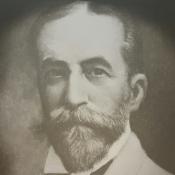Charles Ezra Sprague
 The son of Ezra and Elisabeth Brown Edgerton Sprague was born on October 9, 1842, in Nassau, New York. His primary education was obtained in the Amsterdam, New York district schools and his secondary education in the Amsterdam Academy. He received a bachelor's degree with Phi Beta Kappa honors from Union College in 1860. He also received a master's degree in 1862 and an honorary Doctor of Philosophy degree in 1893 from Union College. In 1910 he received an honorary Doctor of Letters degree from Olivet College.
The son of Ezra and Elisabeth Brown Edgerton Sprague was born on October 9, 1842, in Nassau, New York. His primary education was obtained in the Amsterdam, New York district schools and his secondary education in the Amsterdam Academy. He received a bachelor's degree with Phi Beta Kappa honors from Union College in 1860. He also received a master's degree in 1862 and an honorary Doctor of Philosophy degree in 1893 from Union College. In 1910 he received an honorary Doctor of Letters degree from Olivet College.
After college he taught at Greenwich Union Academy for a year and a half before enlisting in the New York National Guard in 1862. He saw active service in the Civil War until he was wounded and disabled during the Battle of Gettysburg (1863). For his gallant and meritorious service in that battle he was made a brevet colonel in the New York Volunteers (1868). During the period 1864-70 he taught at Yonkers, Peekskill, and Poughkeepsie military academies. He again served in the New York National Guard during the periods 1870-72 and 1897-1901. During the latter period he served as assistant paymaster general for the National Guard of the State of New York, with the rank of Colonel.
In 1870 he joined the Union Dime Savings Bank in New York City as a clerk. In 1877 he became secretary, then treasurer and in 1892, president, the position he held at his death (1912). He was a pioneer in designing and implementing various devices and systems to the operations of savings banks, designer of the first machine for making ledger entries, originator of amortization methods, and the introducer of small checkbooks, passbooks, and looseleaf ledgers. He served as president (1904-05) of the Savings Bank Section of the American Bankers Association.
He played a prominent role in drafting the first CPA law in the state of New York in 1896. In that state he served as one of the three members of the first State Board of Examiners for CPAs. He was certified as a CPA in 1896 (New York). He served as a member of the Board of Directors of the New York State Society of CPAs. He was also affiliated with the AICPA and the American Bankers Association.
He was instrumental in organizing and developing the School of Commerce, Accounts, and Finance (the first of its kind in the world) at the New York University in 1900. He was a member of the original accounting faculty during the evenings from 1900 until his death. Due to his devotion to the profession of accounting, he lectured without compensation. He was alumni trustee (1894-98) and life trustee (1906 - resigned shortly before his death) of Union College. He wrote many articles for professional journals and among his authored books are The Algebra of Accounts (1880), The Accountancy of Investment (1904), Extended Bond Tables (1905), Problems and Studies in the Accountancy of Investments (1904), Tables of Compound Interest (1907), The Philosophy of Accounts (1907), Amortization (1908), Logarithms to Twelve Places and Their Use in Interest Calculations (1910). He was associate editor of the periodical The Bookkeeper (1881-84). The publication's name was changed in 1883 to the American Counting Room and the last recorded issue was April-June 1884.
He married Ray Ellison on April 2, 1866; they had four children. He enjoyed studying obscure languages and unusual dialects; he was considered the first American advocate of the artificial language of Volapuk on which he wrote the Handbook of Volapuk in 1888. He spoke 16 languages. He also enjoyed brass band music, croquet, and simplified spelling. He died on March 21, 1912 at the age of 69.
 The son of Ezra and Elisabeth Brown Edgerton Sprague was born on October 9, 1842, in Nassau, New York. His primary education was obtained in the Amsterdam, New York district schools and his secondary education in the Amsterdam Academy. He received a bachelor's degree with Phi Beta Kappa honors from Union College in 1860. He also received a master's degree in 1862 and an honorary Doctor of Philosophy degree in 1893 from Union College. In 1910 he received an honorary Doctor of Letters degree from Olivet College.
The son of Ezra and Elisabeth Brown Edgerton Sprague was born on October 9, 1842, in Nassau, New York. His primary education was obtained in the Amsterdam, New York district schools and his secondary education in the Amsterdam Academy. He received a bachelor's degree with Phi Beta Kappa honors from Union College in 1860. He also received a master's degree in 1862 and an honorary Doctor of Philosophy degree in 1893 from Union College. In 1910 he received an honorary Doctor of Letters degree from Olivet College.